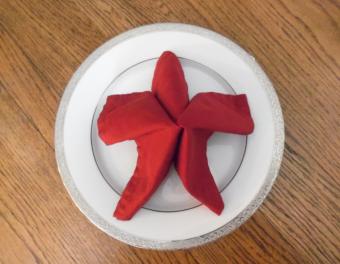
Fabric origami offers crafters an opportunity to make artistic objects out of fabric. People can choose from a variety of fabrics for origami projects. Fabric folding designs include animals and objects as well as quilting and clothing designs. Adults and children can learn this versatile form of origami.
Types of Fabric Origami
There are six types of common types of fabric origami--general fabric folding, towel folding, napkin folding, quilts, clothing and toys. Each one employs a form of folding fabric into an object or design.
General Fabric Folding
Fabric origami designs are usually different than paper designs because the soft folds do not hold creases well. However, fabric can be treated so that it can be folded into some of the same designs as paper origami. In fact, origami artist Glenda from the Fabric Origami site is known for a fabric folding technique that incorporates many of the same complex designs as traditional origami. Glenda treats fabric with a stiffener so that it can be folded like paper.
Towel Folding
People can fold towels into artistic designs. Animal shapes are the most common design type. Creative towel designs can make a lovely presentation in a guest bathroom or gift basket. The towel's rectangular shape and soft texture may make some designs challenging, however. To overcome these obstacles, many people use wash cloths or cut towels into a square shape for art projects. The use of rubber bands can also help towels hold a shape.
Napkin Folding
Cloth napkins are commonly folded into artistic designs as part of a place setting presentation in restaurants. Formal dinners, weddings and black-tie events may all include a place setting with artistically folded napkins. Many catering and party websites provide free instructions for napkin designs.
Quilts
Folded fabric has become a popular design element in modern quilt making. Quilt crafters usually sew a folded fabric block directly into a quilt or add a design to a quilt as an appliqué. Typical designs include flowers, stars and animals.
Clothing
Fabric origami can also be incorporated into clothing. Known as orinuno, folded fabric art objects are sewn onto clothing as a part of the outfit design. Some origami festivals, such as the Masters of Origami festival in Japan, feature wearable origami clothing. Fashion designer Reiko Sudo created a number of origami outfits and accessories.
Toys
Simple handmade toys can be created by folding fabric. Parents can fold fabric into toys during playtime with young children. In minutes, a mother can transform a cloth diaper into a puppet. During bath time, a small child will love seeing her wash cloth folded into a puppy shape.
How to Select Fabric for Origami Projects
People can use just about any fabric for origami. Here is some helpful information to keep in mind when selecting fabric:
- Choose fabric based upon the design project.
- Select fabric of thin or medium thickness for projects that will be folded flat or for complex designs.
- Use thick fabrics, like towels, for projects that do not require defined folds.
- Pick complimentary colors for designs that mix two fabrics.
- Cotton fabric may respond better to a stiffener.
Tips for Folding Fabric
Folding fabric presents a challenge because the soft texture does not hold creases well during folding. Additional measures are sometimes necessary get fabric to hold a shape. These measures include:
- Apply a stiffener to the fabric so that it can be folded into complex designs with as much ease as paper.
- Use rubber bands in strategic places to keep the fabric in place.
- Fasten design elements to fabric such as ribbons, buttons or sunglasses that also help hold the fabric in the desired shape.
Diagrams and Instructions
The Internet has a number of free printable fabric origami diagrams and instructions. The following websites have printable diagrams or instructions:
- Jembellish: The site provides a tutorial with photos and instructions on how to make an origami bag.
- Ashlee Marie: The Zen Craft blog has instructions on how to make a fabric origami star ornament.
- Instructables: The web page provides instructions and photos for making origami quilt blocks.
- Napkin Folding Guide: The site provides illustrated instructions for 27 different napkin designs.
Additional Resources
There are many ways to learn fabric origami. Look at the library and local craft stores for books on the subject. Search for a fabric origami class or craft group. Even if local classes are not available, the Internet provides a large number of resources. Online fabric origami websites include:
- Origami Resource Center: The Origami Resource Center has information on different types of fabric origami and links to helpful resources.
- Craft Stylish: Craft Stylish has articles on fabric folding, including how to use scrap material to make origami designs for clothing.
- Burda Style: Burda Style has information and instructions on fabric folding techniques.
Research origami websites, studying the fabric examples and folding techniques for ideas that can be adapted for your own projects. The large selection of information on the Internet can provide all the information necessary to learn the craft. With a little practice, anyone can create fabric origami designs.







